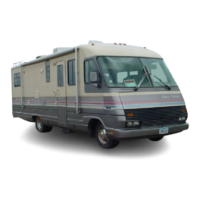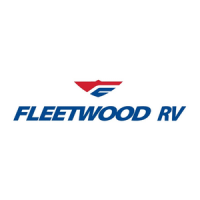45
Discovery, Discovery LXE, Pace Arrow, and Pace Arrow LXEt
Tire Pressure
The motorhome may weigh
slightly heavier on one side.
The heaviest wheel position (if
applicable) on a single axle will
determine the ination pressure for
all tires on that axle due to weight
transfer that occurs when cornering.
Improperly inated tires can result
in sudden tire failure (blowout).
Cargo not properly balanced on
the suspension, can result in poor
handling, over-stressed chassis
components, overloaded wheel
positions and/or tires.
How the motorhome is loaded
will inuence tire ination pressure
and load carried by each axle. This
is why each wheel position must be
weighed. When the actual loaded
weight of the motorhome and the
weight on each axle are unknown,
follow the recommended tire
ination pressure(s) listed on the
federal certication label.
NOTE:
When adjusting tire inflation
pressure, each tire on any
axle must be inflated to the
same pressure. The wheel
position carrying the most
weight will determine the
tire inflation pressure for
each tire of that particular
axle.
WARNING:
Improperly inflated or
overloaded tires can cause
a blowout. An overloaded
axle can cause a component
failure of the suspension
system. Tire blowouts
or broken suspension
components can lead to loss
of vehicle control resulting in
property damage, personal
injury or death.
NOTE:
Contact the tire
manufacturer for further
information concerning tire
inflation pressure and other
tire concerns.
Occupant & Cargo Carrying
Capacity:
Each motorhome, even of the
same model year, oor plan and
length, will weigh different due to
options and accessories. The GVWR
limits the weight of the entire load
combination, regardless of the
amount of weight of occupants,
cargo, water, propane and tongue
weight. Weighing will determine
the GVWR is not exceeded as this
is maximum allowable weight.
However, Occupant & Cargo
Carrying Capacity (OCCC) weight
is comprised of variables in
occupants, cargo, fresh water and
tongue weight.
While the OCCC is a guide to
the maximum allowable weight
in combinations of occupants,
cargo, water and tongue weight,
the amount of weight in each of the
categories (occupants, cargo, and
water and tongue weight) can be
adjusted so one can offset another or
reduced entirely to gain advantage
in GCWR. While maximum
allowable weights are
not to be exceeded, if
one chooses to carry
less water or no water,
that can allow an
increase in payload of
cargo or tongue weight,
offsetting one for
another and still under
maximum allowable
weight of GVWR,
GAWR, GCWR or
OCCC.
Scales
Certied public scales are located
in moving and storage lots, farm
supplies with grain elevators, gravel
pits, recycling companies and large
commercial truck stops. To locate
a nearby public scale, check the
yellow pages under Scales-Public or
Weighers. Expect to pay a small fee.
Three basic types of scales:
A large platform scale will
allow the entire motorhome
to t on the scale to read the
gross vehicle weight in one
scale recording.
A segmented platform scale
is designed to weigh one
axle at a time.
A segmented platform scale
per wheel position reads
each wheel position at a
time.
Single Platform
Segmented Platform per axle.
Segmented Platform (Top View) per wheel position.
100233
020369b

